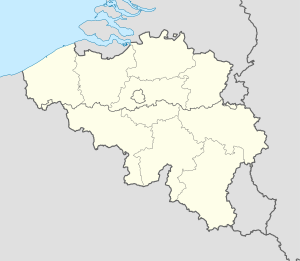Fort de la Chartreuse
| Fort de la Chartreuse | |
|---|---|
| Part of Fortifications of Liège | |
| Liège, Belgium | |
 Abandoned building, Fort de la Chartreuse | |
| Coordinates | 50°37′54″N 5°35′46″E / 50.631688°N 5.596161°E |
| Type | Fort |
| Site information | |
| Owner | State of Belgium |
| Controlled by | Belgium |
| Open to the public | Yes |
| Condition | Abandoned, parkland |
| Site history | |
| Built | 1817 |
| Materials | Masonry |
| Battles/wars | Battle of Liège |

The Fort de la Chartreuse, which dominates the Amercœur neighborhood of Liège in Belgium, was built between 1817 and 1823 to defend the city.
History
The fort is built on a strategic height that dominates the valley of the Meuse, which had been occupied by a Carthusian (Ordre des Chartreux) monastery until the French Revolution. The fort was built by the Dutch, who at the time administered southern Belgium.


The fort was abandoned as a fortification by the military in 1891 and was thereafter used as a barracks. From 1914 to 1918 the Germans used it as a prison, and again from 1940 to 1944. In 1944-1945 it was used by the Americans as a military hospital. The Belgian army left the site in 1988.
Environment
The greater part of the fort occupies a green space that is being reforested. The ramparts and glacis are covered with vegetation.
See also
Sources
- This article incorporates text translated from the corresponding French Wikipedia article as of August 13, 2012.
Bibliography
- Brasseur, Th. (1993). La Chartreuse : forteresse hollandaise en sursis. Centre Nature & Patrimoine, Flémalle.
- Brasseur, Th. (1994). La Chartreuse de Liège. Centre Nature & Patrimoine, Flémalle.
- Liénard, J.(2000). Le fort de la Chartreuse, création hollandaise (1818-1823) à Liège. Bulletin d'information du C.L.H.A.M., 9 : 5-28.
- Loxhay, J. (1995). Le fort de la Chartreuse. Historique de la genèse à nos jours. PIMM'S Edition, Liège.
- Metzmacher, M. (1990). Les milieux semi-naturels: des outils pour concilier loisirs et éducation à la nature. Le cas des milieux semi-naturels urbains et péri-urbains. In : Actes du colloque "Gérer la nature?", Travaux Conservation de la nature, 15/2 :593-606.
External links
- La Chartreuse (in French)
- Fabrice Muller's page on the Fort de la Chartreuse (in French)
- Virtual Tour, Fort de la Chartreuse Liège, 2014 (in French)
- Photos from abandoned Fort de la Chartreuse on Lost-Place.org (in German)

